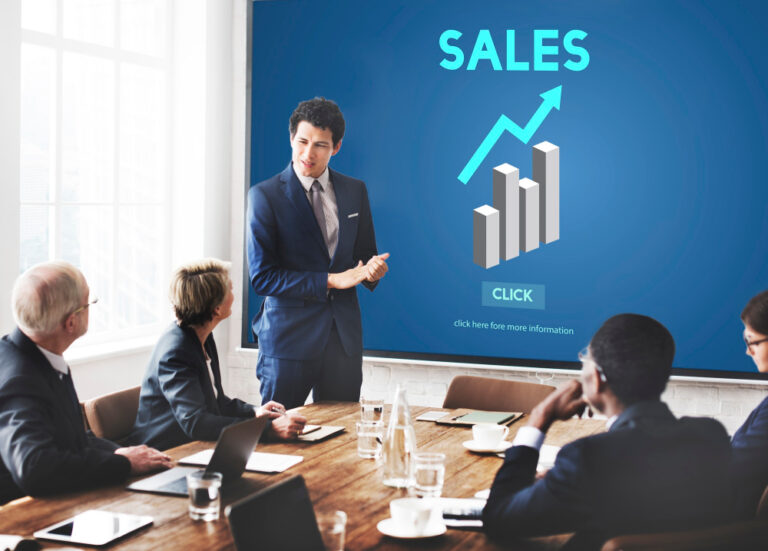Create a Lead Generation Funnel: Step-by-Step Guide
As a small business owner, I’ve faced the challenge of attracting the right leads.
It’s tough to see your efforts pay off in growth.
I’m excited to share my knowledge on creating a lead generation funnel.
I’ve learned that guiding potential customers through a smooth sales process is key. This process captures their interest and nurtures them until they’re ready to buy.
In this guide, I’ll walk you through how to build such a funnel.
We’ll use proven marketing strategies and data insights.
If you’re new to lead generation strategies or want to improve your sales funnel optimization, this article is for you.
It will give you the tools to attract, engage, and convert your ideal clients.
Let’s explore how to build a successful online marketing funnel that boosts your business.
What is a Lead Generation Funnel?
A lead generation funnel is a way to attract and convert potential customers into leads. It guides your audience through stages until they buy something.
You use ads, content, and videos to grab their attention and get them to act.
Lead magnets, like checklists and ebooks, are key in this process.
They encourage people to give you their email address. Then, you can send them targeted emails to keep them interested.
Landing pages are important because they’re the first thing people see.
They need a catchy headline, good images, and a strong call to action. A lead capture form is also essential to get people’s contact info.

“The more efficiently a lead generation funnel operates, the more opportunities for profit earnings emerge.”
Using email marketing platforms with your landing page builder makes managing leads easier.
Automated email sequences help build trust and guide people towards buying.
These emails usually last five to seven messages.

Getting people to your content is crucial. SEO, social media, and search ads can help.
A good lead generation funnel works well for both B2B and B2C businesses.
It helps you focus your efforts and turn leads into customers.
Understanding the Funnel Stages
The journey to lead generation is not always straightforward. Businesses use a lead generation funnel to guide potential customers.
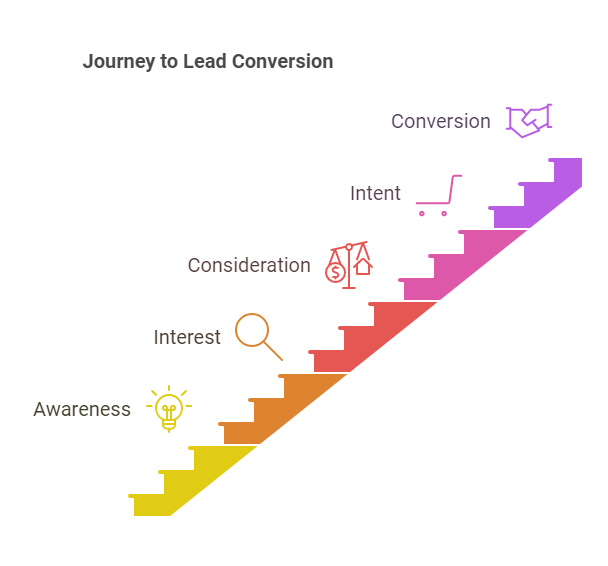
This funnel helps them move from awareness to conversion. Knowing the funnel stages is key to improving your marketing and success.
Stage 1: Top of Funnel Leads (TOFU – Awareness)
At the top, leads are just starting to notice a problem.
They’re looking for solutions and gathering info.
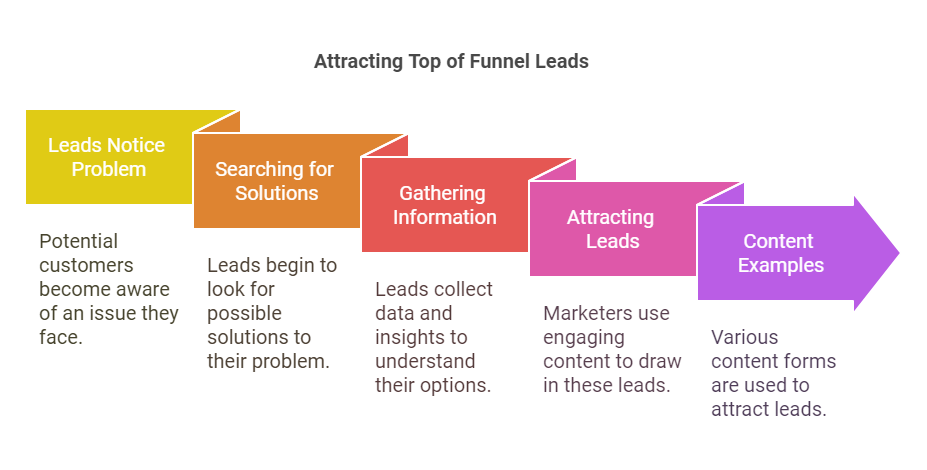
Your job is to attract these leads with valuable content.
This could be blog posts, social media, or webinars that solve their problems.
Stage 2: Mid-Funnel Leads (MOFU – Consideration)
Leads in the middle are now thinking about solutions. You should give them detailed info to compare your offer with others.

Use case studies, demos, and free trials to help them decide.
Stage 3: Bottom of Funnel Leads (BOFU – Conversion)
Leads at the bottom have chosen your solution.
Now, they’re ready to make a purchasing decision.
Offer them a clear call-to-action, like a free consultation or discount. Targeted content and offers can boost your conversion rates.
The lead generation funnel is not a one-size-fits-all solution.

Every customer’s journey is different.
Analyze and optimize your funnel based on data. By meeting the needs of your leads at each stage, you’ll build a successful business.
Map Your Customer Journey
Understanding your customer journey is key to a good lead generation funnel.
You can spot pain points by mapping out your customers’ steps, from awareness to conversion.
You can also improve touchpoints and give a smooth experience that keeps them interested.
Leverage Website Analytics
Begin by looking at your website analytics. Use tools like Google Analytics to check bounce, traffic, and conversion rates.
This helps you see how users move through your site and where they might stop.
Conduct Customer Research
Also, customer interviews and surveys will be conducted, and support tickets will be reviewed.
Talking directly to your customers reveals their challenges and what drives them.
This info is crucial for making buyer personas and improving the customer journey.
“Customer journey mapping involves gathering data from various sources, including customer feedback, analytics, and internal insights to fully understand customer experiences.” – Medstar Media
Good customer journey mapping can boost conversions by 500% and increase revenue by millions,
MedStar Media found. Knowing your customers’ needs and improving their experience can grow your business.
Create Great Content
In the digital marketing world, content is key. Content marketing, content creation, and content optimization are vital for success.
You must make content that genuinely connects with your audience to stand out.
It’s essential to optimize your content for SEO best practices. This boosts organic traffic and attracts leads.

You can get online visibility using the right keywords and creating thought leadership and lead magnet content.
Crafting Content for Every Funnel Stage
Your content plan should match the lead generation funnel’s stages.
At the top (TOFU), create engaging blog posts and videos to grab attention. In the middle (MOFU), share detailed content like ebooks to nurture leads.
At the bottom (BOFU), offer special deals to encourage action.
“Content is the fuel that powers the lead generation engine.
By creating high-quality, optimized content for each stage of the funnel, you can effectively guide your prospects through the buyer’s journey and turn them into loyal customers.”
Content isn’t just for the sake of it. It’s about adding value, building trust, and showing your brand’s expertise.
Focus on quality and match your content to your audience’s needs.
This way, your lead generation funnel will keep delivering excellent results.
Drive Traffic to Your Content
Getting people to visit your content is key to your lead generation success. It’s not just about making great content.
You also need a solid plan to get it seen and shared.
Leverage Organic Search (SEO)
Using SEO to boost your content’s search engine ranking is a smart move.
By focusing on SEO strategy, you can draw in more visitors naturally.

Ensure your content meets your audience’s needs and matches what they’re searching for.
Utilize Email Marketing
Email marketing is a great way to get people to your content. Keep your email list engaged with interesting updates.
This will get your audience to visit your site and interact with your content.
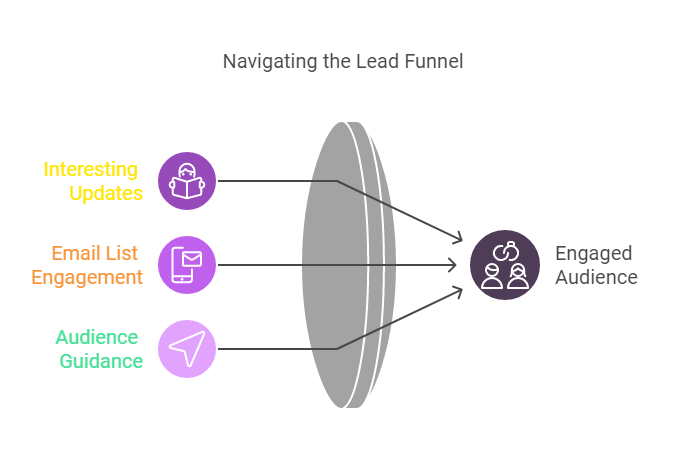
Email marketing helps you stay connected with your audience, guiding them through your lead generation funnel.
Leverage Social Media
Social media marketing is a potent tool for getting your content seen.
Share your work on platforms like LinkedIn, Twitter, and Facebook.
This can help you reach more people and get them to engage with your content.

Regularly posting and chatting with your followers can build a loyal community and increase traffic to your funnel.
Explore Paid Advertising
Adding paid advertising to your strategy can be a wise choice.
Ads on Google, LinkedIn, and Facebook let you target specific groups. This ensures your content reaches the right people.
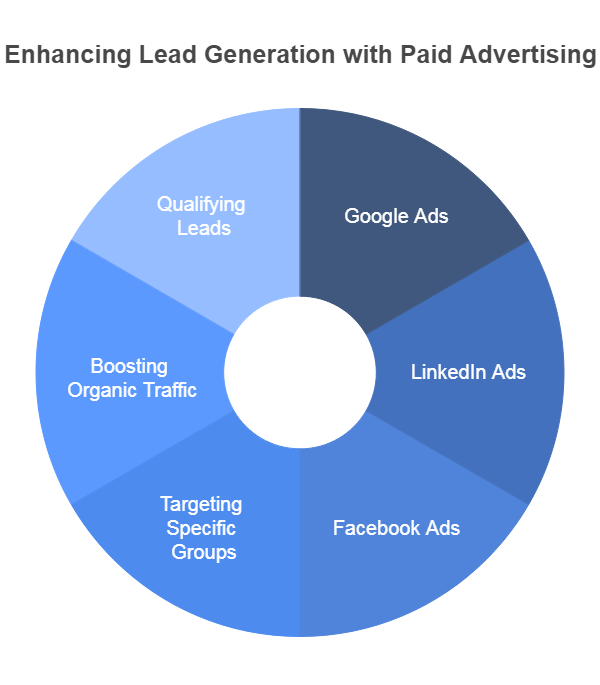
Paid ads can boost your organic traffic and bring more qualified leads to your funnel.
“A comprehensive traffic generation strategy, encompassing SEO, email marketing, social media, and paid advertising,
is essential for driving qualified leads to your content and maximizing the effectiveness of your lead generation funnel.”
Collect Prospect Information
You must capture prospect info right to build a substantial lead generation funnel.
One great way to do this is by creating lead magnets. People can get this valuable content by sharing their contact details.
Lead magnets can be ebooks, guides, webinars, or free trials.
They should be helpful to your audience and match your business. This way, they’ll be more likely to give you their email addresses or other lead capture info.
After you have a lead magnet, promote it on landing pages. These pages should show off your offer’s value.

They should also make it simple for visitors to sign up and get the content. This helps you grow your email list and move leads towards becoming customers.
“Lead generation is the lifeblood of any business. Without a steady stream of new leads, growth stagnates.”
It’s essential to focus on providing value, not just making a sale.
You build trust by offering valuable content and making it easy to access.
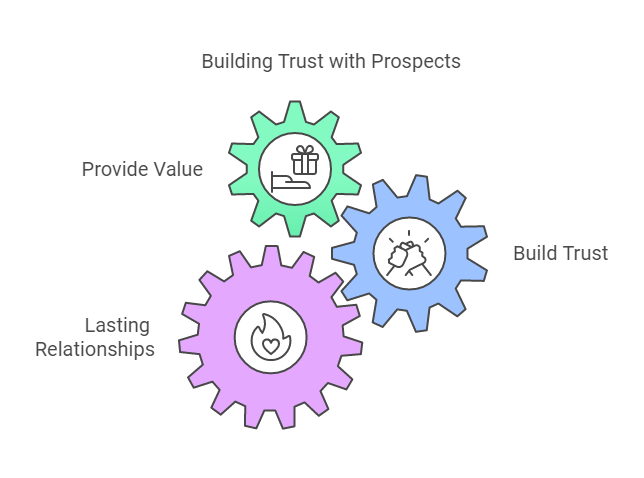
This is the first step towards lasting relationships with your prospects.
How to Create a Lead Generation Funnel
Building a lead generation funnel is key to growing your business.
It’s a multi-step process that guides people from knowing about you to becoming customers.
Let’s look at the main steps to make a lead generation funnel work:
Map Your Customer Journey: Begin by knowing your customers’ steps, from finding your brand to buying from you.
Use tools like Google Analytics to learn about user behaviour and how they move through your funnel.
Create Valuable Content: Make content that teaches and adds value at each funnel stage.
This could be blog posts, videos, webinars, or quizzes. Ensure your content is suitable for search and helps people navigate the funnel.
Drive Traffic to Your Content: Use organic search, email, social media, and ads to get people to your content.
This helps build awareness and moves your audience through the funnel.
Collect Prospect Information:
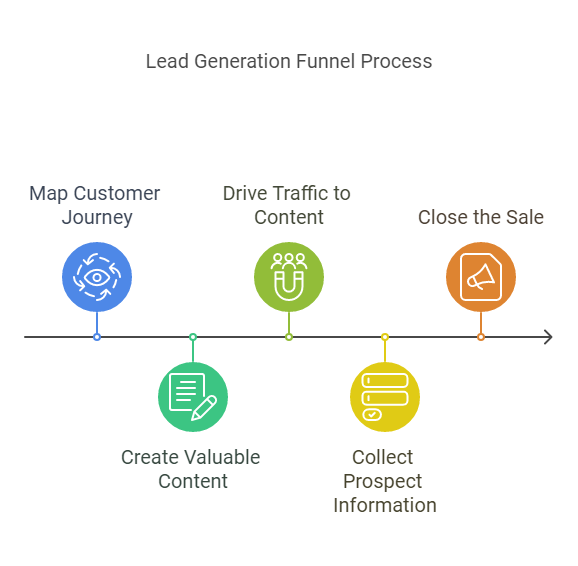
Give away lead magnets like ebooks or free trials to get contact info. This starts the lead nurturing process.
Close the Sale: Use targeted content and offers to guide leads to buying.
Keep an eye on your funnel’s performance and make changes to improve it.
Following these steps, you can make a lead generation funnel that attracts, nurtures, and converts your audience into loyal customers.
Close the Sale
Now, your leads have reached the final stage of the sales funnel.
They’re ready to buy. This is your chance to impress and turn them into loyal customers.

You can make them choose you by nurturing leads with targeted content and offers.
Use content personalization and sales enablement to give your leads what they need. Share customer stories, detailed case studies, and personalized demos.
Also, consider offering special discounts or free trials to help them decide.
At this stage, conversion rate optimization is crucial. Keep checking how your funnel is doing and tweak it based on data.
With the right strategy, you can turn your lead generation into a powerful sales tool. This will help your business grow steadily.
Optimize and Refine Your Funnel
It’s key to keep checking and improving your lead funnel optimization to make it better.
Use tools like Google Analytics to watch vital stats like bounce rates and conversion rate optimization.
Try different versions of your landing pages and lead magnets to see what works best.
You can make your funnel more effective by closely monitoring your funnel analysis and using data-driven marketing.
This helps you tackle the problem of 68% of businesses having trouble with top-tier leads.
Optimizing your funnel is a never-ending job. Be ready to change your approach based on data.
This way, your lead generation will keep bringing excellent results,
like Tate Law’s 654% increase in calls and ThinSlim Foods’ 200% conversion boost.
FAQ
What is a lead generation funnel?
A lead generation funnel is a way to get potential customers. It guides your audience through different stages.
The goal is for them to buy your product or service.
What are the stages of a lead generation funnel?
A lead generation funnel has three main stages:
1. Top of Funnel Leads (TOFU) – Awareness 2. Mid-Funnel Leads (MOFU) – Consideration 3. Bottom of Funnel Leads (BOFU) – Conversion
How do I map my customer journey?
To map your customer journey, use Google Analytics. Look at bounce rates, traffic reports, and conversion rates.
Also, talk to customers, do surveys, and read support tickets to understand their needs.
What makes great content for a lead generation funnel?
Great content beats the competition by being more valuable and informative. Make sure it’s optimized for SEO to get more organic traffic.
How can I drive traffic to my lead-generation content?
Drive traffic through organic search, email marketing, social media, and paid ads. This will help more people see your content.
How do I collect prospect information?
Create lead magnets like guides or ebooks. Use landing pages to get visitor information in exchange for the content.
What are the steps to create a lead generation funnel?
The five key steps are:
1. Map your customer journey 2. Create great content 3. Drive traffic to your content 4. Collect prospect information 5. Close the sale by nurturing leads
How do I close the sale with lead generation?
Nurture leads with targeted content and offers. Share testimonials, offer demos and trials, and use discount codes to encourage purchases.
How do I optimize and refine my lead generation funnel?
Continually analyze and optimize your funnel. Use Google Analytics to track essential metrics. Do A/B testing to see what works best?
Refine your targeting, messaging, and offers based on your findings.






